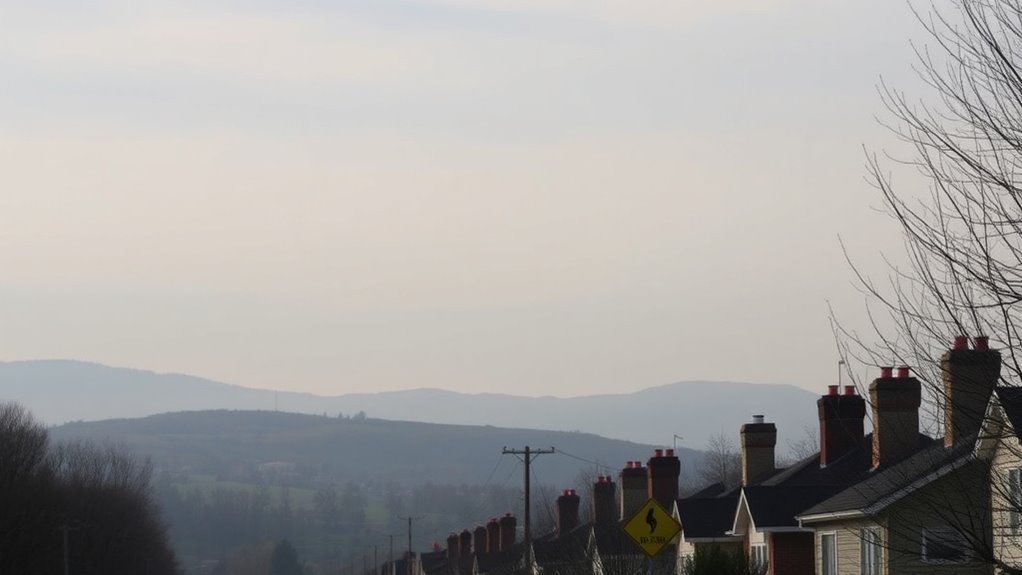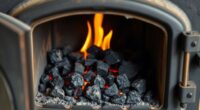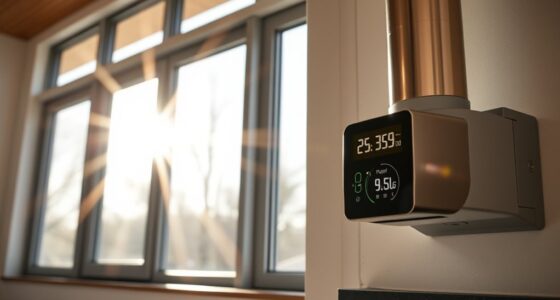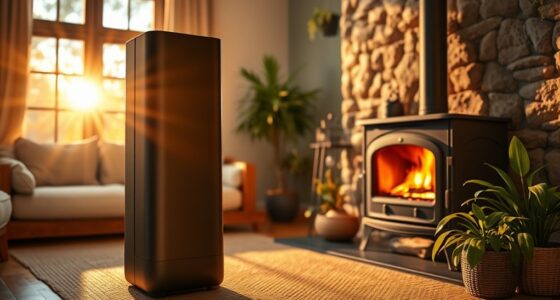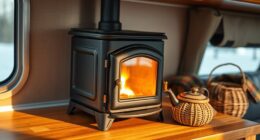During burn bans and no‑burn days, you can’t use your stove, fireplace, or open flames to help protect air quality and reduce wildfire risk. These restrictions are typically announced through local alerts and aim to prevent smoke and particulate pollution. Electric or gas appliances are usually allowed—just check your local guidelines. Staying compliant keeps everyone safe and supports wildfire prevention efforts. Continue here to discover more helpful tips on managing restrictions comfortably.
Key Takeaways
- During burn bans or no-burn days, using stoves or fireplaces is prohibited to reduce smoke and wildfire risk.
- Official announcements notify residents when restrictions are in effect, typically during high wildfire danger periods.
- Electric or gas stoves are generally permitted; verify local regulations to confirm.
- Plan ahead by stockpiling supplies and switching to alternative heating and cooking methods before restrictions begin.
- Compliance helps protect air quality, public health, and reduces the likelihood of wildfire incidents.
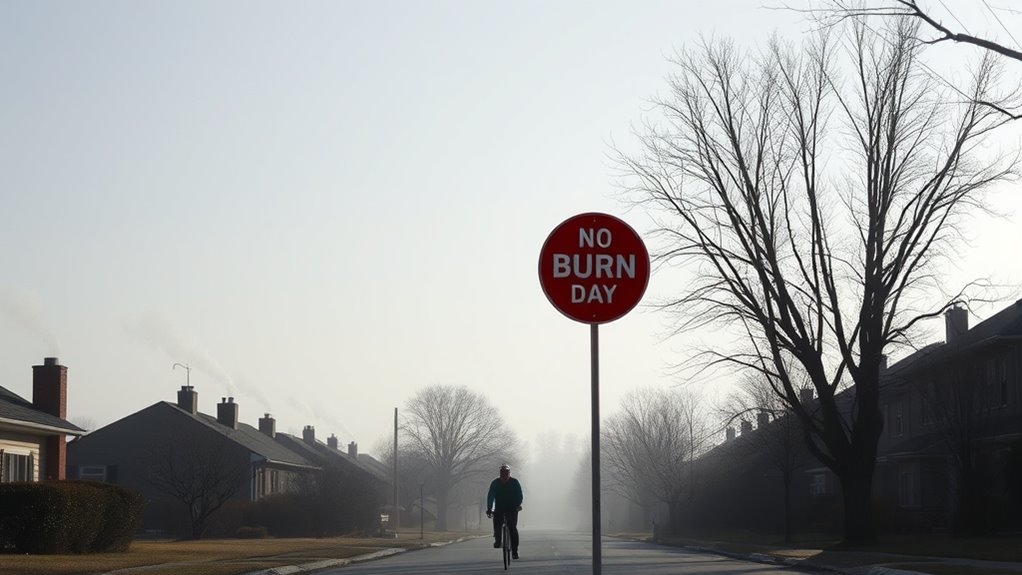
During certain times of the year, local authorities issue burn bans and designate no-burn days to protect air quality and public health. These restrictions are essential, especially when the risk of wildfires increases. When a burn ban is in effect, you must refrain from using your stove, fireplace, or any open flame that could ignite a fire. The goal is to reduce smoke and particulate emissions, which can worsen air quality and pose health risks, particularly for vulnerable populations like children, the elderly, and those with respiratory conditions. By avoiding wood burning during these periods, you’re actively contributing to wildfire prevention efforts, helping to minimize the chances of accidental fires sparked by unattended or improperly managed fires.
During burn bans, avoid using open flames to protect air quality and prevent wildfires.
Understanding when burn bans are in place can save you from accidental violations and potential fines. Usually, local authorities announce these bans through official channels, including websites, social media, and community alerts. During no-burn days, it’s important to be vigilant and plan alternative ways to heat or cook. Electric or gas appliances are typically allowed, but it’s best to double-check local regulations to guarantee compliance. Not only does this help in wildfire prevention, but it also supports healthier air quality within your community. Smoke from wood stoves and outdoor burning contributes considerably to air pollution, and limiting this activity during high-risk periods can make a real difference in reducing pollution levels.
You might wonder about the practical aspects of managing your household during a burn ban. For heating, consider using electric heaters or upgrading insulation to keep your home warm without relying on wood or coal. For cooking, switch to electric or gas appliances if possible. If you rely on a fireplace, you’ll need to find alternative heating options until the ban is lifted. It’s also wise to prepare ahead of time by stocking up on necessary supplies, so you don’t have to rely on burning wood during restricted periods. This proactive approach ensures your comfort and safety while supporting community-wide wildfire prevention efforts.
In addition to personal precautions, staying informed about burn bans can help you protect your health and the environment. When authorities declare a no-burn day, think of it as a community effort to improve air quality and prevent wildfires. Your cooperation not only keeps you safe but also contributes to the broader goal of wildfire prevention, which benefits everyone living in fire-prone areas. Additionally, understanding the science behind sound vibrations and their impact on health can help you find alternative relaxation methods during these times. By respecting these bans, you’re playing an essential role in maintaining cleaner air and reducing the threat of destructive fires.
Frequently Asked Questions
How Are Burn Bans Enforced in Different Regions?
Regional enforcement of burn bans varies widely; authorities typically monitor air quality and weather conditions. In some areas, local fire departments or environmental agencies enforce bans through patrols and fines, while others rely on community reporting. Regional variation means enforcement strategies differ—some regions implement strict patrols, others use public alerts or social media. You should stay informed about specific local regulations, as enforcement methods depend on regional priorities and resources.
Can I Be Fined for Burning During a Ban?
Yes, you can be fined for burning during a ban. Authorities enforce fire safety tips to prevent wildfires, so ignoring restrictions can lead to penalties. Instead, consider alternative heating options like electric or gas heaters, which are safer during no-burn days. Always respect burn bans to protect your community and environment. Staying informed and following local regulations helps keep everyone safe and avoids costly fines.
Are There Exceptions for Emergencies During Burn Bans?
In emergencies, you may find a gentle exception to burn ban violations. Emergency exceptions typically allow you to use your stove if it’s essential for safety or health reasons, but you should notify local authorities if required. Always check specific regulations, as rules vary. While these exceptions exist, misuse or neglect during a burn ban can lead to fines, so it’s best to seek approval beforehand and document your situation carefully.
How Can I Stay Updated on Local Burn Restrictions?
To stay updated on local burn restrictions, you should regularly check your city or county’s official fire safety website or social media channels. Sign up for emergency alerts to get real-time updates. Local news outlets also provide timely info on outdoor cooking bans. Staying informed helps you follow burn bans safely, ensuring you don’t accidentally violate restrictions and compromise fire safety.
What Alternatives Exist for Heating During No-Burn Days?
During no-burn days, you can turn to electric heating, use portable electric heaters, or explore wood alternatives like pellet stoves or electric fireplaces. These options keep your home warm without violating burn restrictions. You might also consider space heaters or heated blankets to stay cozy. By choosing electric heating or wood alternatives, you guarantee comfort while respecting burn bans and staying safe.
Conclusion
Remember, when burn bans and no-burn days are in effect, your stove becomes a forbidden treasure. Ignoring these rules isn’t just risky—it can spark a wildfire that consumes everything in its path. Respect these restrictions like your community’s safety depends on it because, in truth, it does. By following the rules, you help protect lives, homes, and the environment. Stay vigilant, stay responsible, and keep the flames of safety burning bright.

